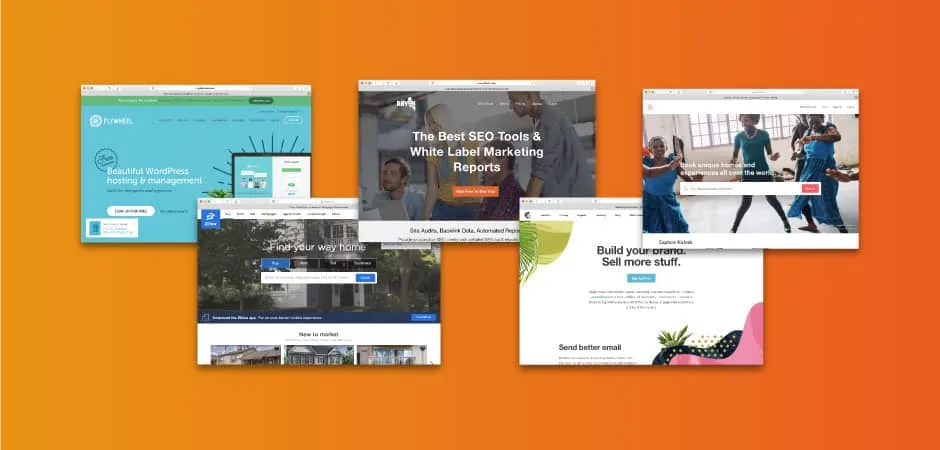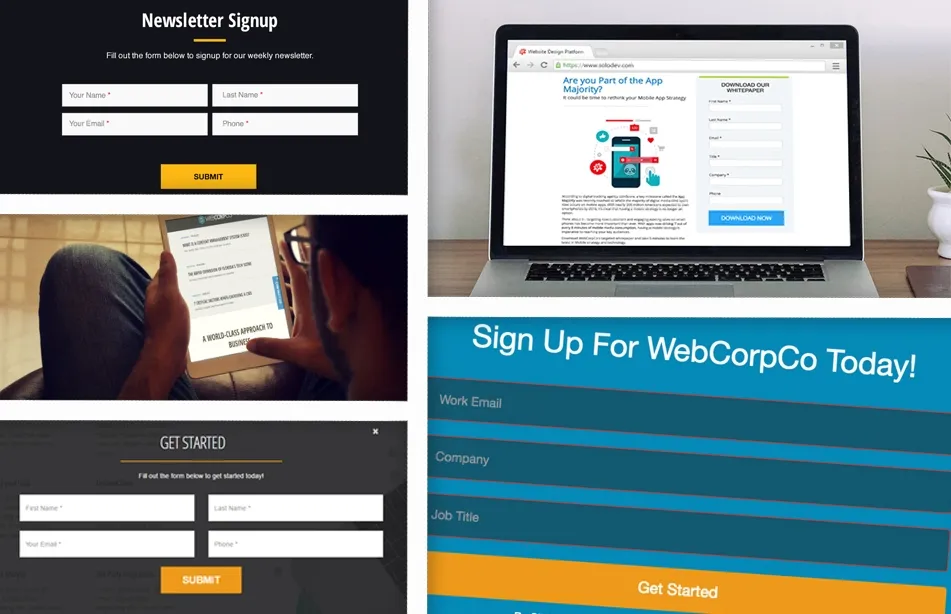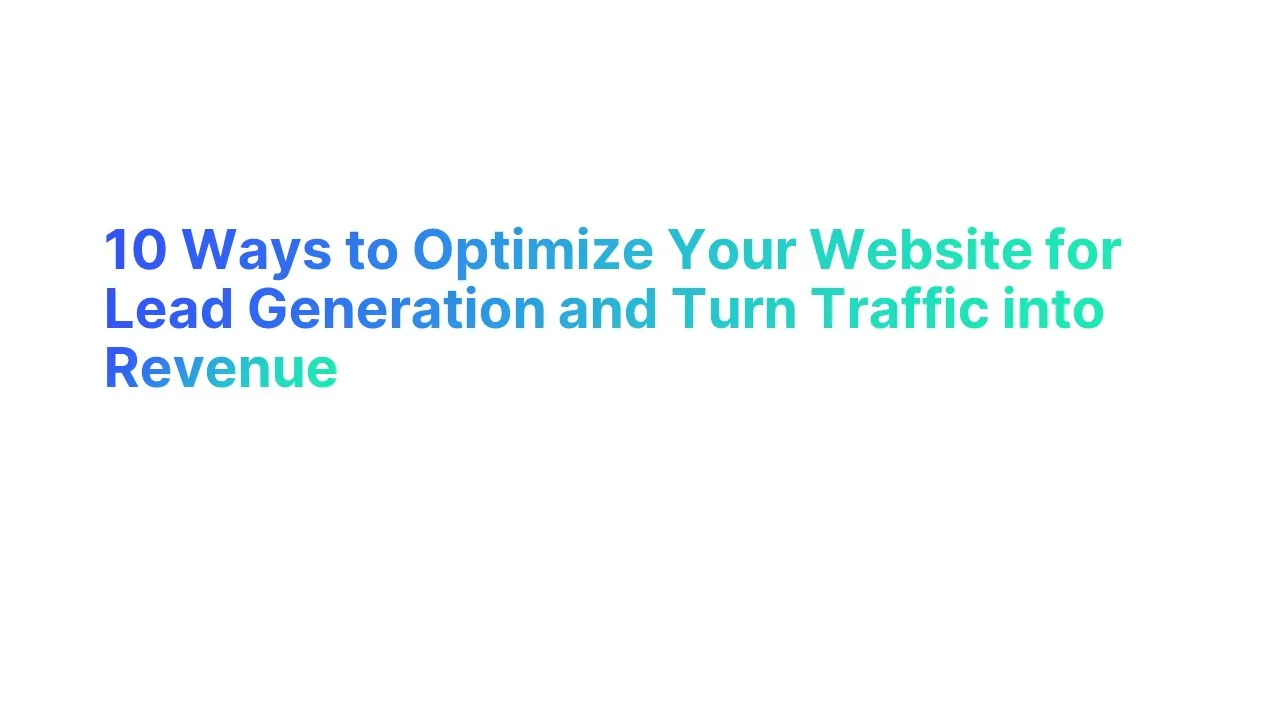Introduction to Lead Generation Websites

Lead generation websites are designed to attract and convert visitors into potential customers by capturing their contact information. They typically use strategies such as offering valuable content, providing clear calls-to-action, and using forms to gather leads.
According to HubSpot, companies that prioritize lead generation websites are 50% more likely to generate high-quality leads. Additionally, businesses with lead generation websites see an average of 133% more revenue than those without.
Why You Should Optimize Your Website for Lead Generation
Optimizing your website for lead generation is crucial for business growth and success. By enhancing your site’s ability to attract and convert visitors into potential customers, you can significantly boost your sales and revenue. Here’s why you should prioritize this strategy:
Increased Conversion Rates
Optimizing your website for lead generation improves the user experience, making it easier for visitors to engage with your content and take action.
- Clear Calls-to-Action (CTAs): Well-placed and compelling CTAs can increase conversion rates by 121% (WordStream).
- User-Friendly Design: A seamless and intuitive website design can lead to a 200% increase in conversion rates (Forrester Research).
Enhanced Customer Insights
By collecting data from your leads, you gain valuable insights into customer preferences and behaviors, which can inform your marketing strategies.
- Data Collection Forms: Forms that ask for specific information help you understand what your customers are looking for.
- Analytics Tools: Using tools like Google Analytics can help track user behavior, providing actionable data to improve your site.
Cost-Effective Marketing
Lead generation through your website is often more cost-effective than other marketing methods.
- Higher ROI: Businesses that focus on inbound marketing (which includes lead generation websites) see a 61% lower cost per lead than those using outbound marketing tactics (HubSpot).
- Scalable Strategies: Once set up, lead generation websites can continuously attract and convert leads without significant additional investment.
Improved Brand Credibility
A well-optimized website positions your brand as an authority in your industry, building trust with potential customers.
- Professional Appearance: Websites that are clean, professional, and easy to navigate instill confidence in visitors.
- Quality Content: Offering valuable content, such as blog posts, ebooks, and webinars, can establish your brand as a knowledgeable leader.
Long-Term Growth
Investing in website optimization for lead generation sets the foundation for sustainable business growth.
- Consistent Lead Flow: A properly optimized website ensures a steady stream of leads, supporting ongoing sales efforts.
- Adaptability: As your business grows, your website can be easily updated to incorporate new lead generation strategies and technologies.
Key Factors to Consider When Optimizing Your Website for Lead Generation

Optimizing your website for lead generation requires careful consideration of various elements to ensure maximum effectiveness. Here are key factors to keep in mind:
User Experience (UX)
A seamless and intuitive user experience is crucial for keeping visitors engaged and encouraging them to convert.
- Navigation: Ensure your website is easy to navigate with a clear structure. 94% of users say easy navigation is the most important feature of a website (Clutch).
- Load Time: Pages that load within 2 seconds have a 9% higher conversion rate than slower pages (Think with Google).
- Mobile Optimization: With over 50% of web traffic coming from mobile devices, ensure your site is mobile-friendly (Statista).
Compelling Content
High-quality, relevant content can attract and retain visitors, ultimately leading to more conversions.
- Value Proposition: Clearly communicate the benefits of your product or service. Companies with clear value propositions see an average of 66% increase in conversion rates (MarketingExperiments).
- Engaging Formats: Use various content formats like blogs, videos, and infographics to cater to different audience preferences.
Effective Calls-to-Action (CTAs)
CTAs are crucial for guiding visitors towards taking desired actions, such as filling out a form or downloading a resource.
- Visibility: Place CTAs prominently on your pages to capture attention.
- Clarity: Use clear, action-oriented language. CTAs with personalized messages perform 202% better than basic ones (HubSpot).
Lead Capture Forms
Forms are essential for collecting visitor information and turning them into leads.
- Simplicity: Keep forms short and straightforward. Forms with 3-5 fields have the highest conversion rates (HubSpot).
- Placement: Position forms strategically on high-traffic pages and alongside compelling content.
Social Proof
Showcasing testimonials, reviews, and case studies can build trust and credibility with potential leads.
- Testimonials: 72% of consumers trust online reviews as much as personal recommendations (BrightLocal).
- Case Studies: Detailed case studies can demonstrate the effectiveness of your product or service.
Analytics and Tracking
Monitoring your website’s performance is essential for continuous improvement.
- Metrics: Track key metrics like bounce rate, conversion rate, and average session duration.
- Tools: Utilize tools like Google Analytics and heatmaps to gain insights into user behavior and identify areas for optimization.
SEO and Keywords
Optimizing your website for search engines can increase visibility and drive organic traffic.
- Keyword Research: Identify and incorporate relevant keywords into your content and meta descriptions. Businesses that blog consistently receive 55% more website visitors (HubSpot).
- On-Page SEO: Optimize titles, headers, and images with appropriate keywords to improve search engine rankings.
How to Create a Lead Generation Website

Creating a lead generation website involves several critical steps to ensure it effectively attracts and converts visitors into leads. Here’s an in-depth guide on how to create a successful lead generation website:
1. Start with a Goal
The foundation of any effective lead generation website is a clear and specific goal. Your goal will guide your decisions throughout the creation process.
- Define Your Objectives: Determine what you want to achieve with your lead generation website. Common goals include increasing email subscriptions, gathering contact information for sales outreach, or promoting a specific product or service.
- Identify Your Target Audience: Understand who your ideal customers are, what their needs and pain points are, and how your product or service can solve their problems. This understanding will shape your content and design decisions.
- Set Measurable Goals: Establish key performance indicators (KPIs) to measure the success of your lead generation efforts. These could include metrics like the number of leads generated, conversion rates, and the cost per lead.
2. Find a CMS Tool
A Content Management System (CMS) tool is essential for creating, managing, and optimizing your website. Choose a CMS that aligns with your needs and technical expertise.
- Ease of Use: Look for a CMS that is user-friendly and requires minimal technical knowledge. Popular options include WordPress, Wix, and Squarespace.
- Customization and Flexibility: Ensure the CMS offers flexibility for customization, allowing you to tailor your website to your brand and goals. WordPress, for example, offers numerous themes and plugins for extensive customization.
- SEO Capabilities: Opt for a CMS that provides robust SEO features to help your website rank higher in search engine results. This includes capabilities for optimizing meta tags, alt texts, URLs, and sitemaps.
- Integration with Marketing Tools: Your CMS should integrate seamlessly with email marketing platforms, CRM systems, and analytics tools. This integration is crucial for managing leads and measuring the effectiveness of your campaigns.
- Support and Community: Choose a CMS with strong customer support and an active user community. This can be invaluable when you encounter issues or need advice on best practices.
3. Build a Landing Page
A landing page is a dedicated page designed to capture leads. It’s where visitors arrive after clicking on a marketing link or advertisement, and it should be optimized to convert them into leads.
- Craft a Compelling Headline: Your headline should immediately grab attention and clearly convey the value proposition. It should address the visitor’s problem and hint at the solution your offering provides.
- Provide Value: Offer something valuable in exchange for the visitor’s contact information. This could be a free ebook, a discount, a webinar, or access to exclusive content. Ensure the offer is relevant and enticing to your target audience.
- Design an Intuitive Layout: The layout of your landing page should be clean and straightforward, guiding visitors towards the call-to-action (CTA). Use whitespace effectively to make the page look uncluttered and professional.
- Create Strong CTAs: Your call-to-action should be clear, compelling, and easy to find. Use action-oriented language such as “Download Now,” “Get Your Free Guide,” or “Sign Up Today.” Ensure the CTA stands out visually with contrasting colors and strategic placement.
- Use Engaging Visuals: High-quality images, videos, and graphics can enhance the appeal of your landing page and keep visitors engaged. Visual content should be relevant and support your overall message.
- Incorporate Social Proof: Including testimonials, reviews, or case studies can build trust and credibility, encouraging visitors to take action. Social proof shows potential leads that others have benefited from your offer.
- Optimize for SEO: Ensure your landing page is optimized for search engines. Use relevant keywords in your title, headings, and content. Include meta descriptions and alt text for images to improve your page’s visibility in search results.
- A/B Testing: Continuously test different elements of your landing page, such as headlines, CTAs, and images, to determine what works best. A/B testing can help you refine your approach and increase conversion rates.
10 Ways to Optimize Your Website for Lead Generation

Here are 10 ways to optimize your website for lead generation:
1. Place Forms on High-Traffic Pages
Placing forms on pages that receive the most traffic can significantly increase your lead capture rate. The idea is to strategically position lead capture forms where visitors are most likely to engage with them.
Identify High-Traffic Pages: Use tools like Google Analytics to identify the pages with the highest traffic. These could be your homepage, blog posts, product pages, or landing pages.
Strategic Placement: Position forms in a way that doesn’t interrupt the user experience but is easily accessible. Common placements include:
- Above the Fold: Forms placed at the top of the page can grab immediate attention.
- Sidebar: A form in the sidebar remains visible as users scroll through content.
- End of Content: Placing a form at the end of a blog post can capture leads after they’ve consumed valuable content.
Optimize Form Design: Make forms simple and intuitive to fill out. According to HubSpot, reducing the number of form fields from 4 to 3 can increase conversion rates by 50%.
- Use Clear Labels: Clearly label each field to avoid confusion.
- Minimal Required Fields: Ask for only essential information to reduce friction.
- Visual Appeal: Ensure the form design aligns with your website’s aesthetics for a seamless experience.
2. Track and Analyze Lead Generation Metrics
Regularly tracking and analyzing your lead generation metrics is crucial to understanding what works and what needs improvement. This data-driven approach helps optimize strategies for better performance.
Set Clear KPIs: Establish key performance indicators (KPIs) to measure the success of your lead generation efforts. Common KPIs include:
- Conversion Rate: The percentage of visitors who complete the lead form.
- Cost Per Lead (CPL): The cost associated with acquiring each lead.
- Lead Quality: Metrics like lead-to-customer conversion rate can indicate the quality of leads generated.
Use Analytics Tools: Utilize tools like Google Analytics, HubSpot, or SEMrush to track these metrics. These platforms provide detailed insights into user behavior and lead generation performance.
- Heatmaps: Tools like Hotjar offer heatmaps to see where users click most often, helping to optimize form placement.
- A/B Testing: Conduct A/B tests on different form designs, CTAs, and placements to determine the most effective combinations.
- Regular Reporting: Create regular reports to monitor progress and identify trends. For example, weekly or monthly reports can help spot patterns and make timely adjustments.
3. Streamline the Lead Generation Journey
Streamlining the lead generation journey ensures a smooth and efficient process for users, reducing drop-offs and increasing conversions. This involves optimizing each step a visitor takes from entering your site to becoming a lead.
Simplify Navigation: Ensure your website is easy to navigate so users can quickly find what they’re looking for.
- Clear Menus: Use clear, descriptive labels for menu items.
- Breadcrumbs: Implement breadcrumbs to help users keep track of their location on the site.
Optimize Landing Pages: Landing pages should be focused, persuasive, and optimized for conversion.
- Compelling Headlines: Use headlines that clearly convey the value proposition and grab attention.
- Concise Content: Provide essential information in a concise manner to avoid overwhelming users.
- Strong CTAs: Include a clear and compelling call-to-action that guides users towards filling out the form.
Reduce Friction: Identify and eliminate any obstacles that may hinder the lead generation process.
- Fast Load Times: According to Google, pages that load within 2 seconds have a 15% higher conversion rate than those taking longer.
- Mobile Optimization: Ensure your website and forms are fully optimized for mobile devices, as over 50% of web traffic comes from mobile (Statista).
- Clear CTAs: Use direct and action-oriented language in your CTAs, such as “Download Now” or “Get Your Free Guide.”
4. Implement Clear CTAs on Key Pages
Effective call-to-actions (CTAs) are vital for converting website visitors into leads. A well-designed CTA can guide your visitors toward taking specific actions, such as signing up for a newsletter, downloading a resource, or requesting a consultation.
Clear CTAs are prompts on your website that encourage visitors to take a desired action.
Without clear CTAs, visitors may not know what to do next, leading to missed opportunities for lead generation. Clear CTAs can increase conversion rates significantly; studies have shown that personalized CTAs convert 202% better than basic ones (HubSpot).
How:
- Strategic Placement: Position CTAs prominently on key pages, such as the homepage, landing pages, and high-traffic blog posts. This ensures they are visible and easily accessible.
- Action-Oriented Language: Use concise, compelling language that clearly states the action you want the visitor to take. For example, "Download Now," "Get Your Free Guide," or "Sign Up Today."
- Visual Design: Make your CTAs stand out with contrasting colors, bold text, and eye-catching buttons. The design should draw attention without overwhelming the overall page design.
- Testing and Optimization: Continuously test different versions of your CTAs to determine which ones perform best. A/B testing can help you refine the language, placement, and design to maximize effectiveness.
5. Offer Valuable Resources for Download
Providing downloadable resources is an excellent strategy for lead generation. By offering something valuable in exchange for contact information, you can attract and capture high-quality leads.
Valuable resources can include ebooks, whitepapers, checklists, templates, and industry reports.
Offering valuable resources builds trust and demonstrates your expertise, making visitors more willing to share their contact information. According to Content Marketing Institute, 63% of companies said their lead generation efforts were successful when they offered gated content.
How:
- Identify Audience Needs: Understand what type of content your target audience finds valuable. Conduct surveys, analyze industry trends, and review previous content performance to identify popular topics.
- Create High-Quality Content: Develop comprehensive, well-researched resources that address your audience's pain points and provide actionable insights. The quality of your content reflects your brand’s expertise and credibility.
- Gate the Content: Use lead capture forms to gate your resources. Visitors must provide their contact information to access the download, turning them into leads. Ensure the form is simple and requests only essential information to avoid deterring potential leads.
- Promote Your Resources: Use various channels to promote your downloadable resources, including social media, email campaigns, and blog posts. Highlight the benefits and value of the resource to attract more downloads.
6. Integrate Live Chat Functionality
Live chat functionality on your website can significantly enhance your lead generation efforts by providing real-time engagement with visitors. It allows you to answer questions, provide support, and guide visitors towards conversion.
Live chat is a feature that enables real-time communication between website visitors and your support or sales team.
Live chat can increase lead conversion rates by providing immediate assistance and personalized interaction. According to a study by Forrester, 44% of online consumers say that having questions answered by a live person while in the middle of an online purchase is one of the most important features a website can offer.
How:
- Choose the Right Tool: Select a live chat tool that integrates well with your website and CRM system. Tools like Intercom, Drift, and LiveChat offer robust features for lead generation.
- Set Up Automated Greetings: Use automated greetings to welcome visitors and prompt them to start a conversation. For example, "Hi there! Do you have any questions? We’re here to help."
- Train Your Team: Ensure your support or sales team is well-trained to handle live chat interactions. They should be knowledgeable, responsive, and able to provide helpful information quickly.
- Offer Proactive Assistance: Monitor visitor behavior and initiate chat conversations based on specific actions. For example, if a visitor spends a significant amount of time on a product page, you can proactively ask if they need more information about that product.
- Follow Up: After a live chat interaction, follow up with the visitor via email to thank them for the chat and provide additional information or resources. This helps to nurture the lead and keep the conversation going.
7. Personalize Your Call-to-Actions
Personalizing your Call-to-Actions (CTAs) can significantly increase conversion rates by making the user experience more relevant and engaging. When visitors feel that the content is tailored specifically for them, they are more likely to take the desired action.
Why Personalization Matters: Personalized CTAs perform 202% better than generic ones (HubSpot). This is because personalized messages resonate more with users, making them feel valued and understood.
How to Personalize CTAs:
- Segment Your Audience: Use data to categorize your audience based on demographics, behavior, and interests. Tools like Google Analytics and CRM systems can help in creating these segments.
- Dynamic Content: Implement dynamic CTAs that change based on user behavior or profile information. For example, a returning visitor might see a different CTA than a first-time visitor.
- Use Names and Preferences: If possible, address users by their names and reference their specific interests or previous interactions with your site.
Example: An e-commerce site can show a personalized CTA like "John, check out the latest deals on electronics!" instead of a generic "Check out our latest deals!"
8. Create Lead Nurturing Campaigns
Lead nurturing campaigns are essential for guiding potential customers through the sales funnel by providing them with valuable information and maintaining engagement over time. These campaigns help in building relationships and converting leads into loyal customers.
Why Lead Nurturing is Important: Companies that excel at lead nurturing generate 50% more sales-ready leads at a 33% lower cost (Forrester Research).
How to Create Effective Lead Nurturing Campaigns:
- Segment Your Leads: Group your leads based on their stage in the buying process, interests, and behaviors. This allows for more targeted and relevant communication.
- Automated Email Sequences: Set up automated email sequences that deliver timely and relevant content to your leads. Use marketing automation tools like HubSpot or Mailchimp.
- Provide Valuable Content: Share a mix of educational content, such as blog posts, whitepapers, and webinars, along with promotional offers. Ensure the content addresses the leads' needs and pain points.
Example: A software company could create a nurturing campaign that starts with an introductory email about the product, followed by a series of emails providing case studies, how-to guides, and a free trial offer.
9. Optimize Landing Pages for Conversions
Landing pages are critical in capturing leads as they are specifically designed to prompt a particular action from visitors. Optimizing these pages can greatly enhance their effectiveness in generating leads.
Companies with 30 or more landing pages generate 7 times more leads than those with fewer than 10 (HubSpot).
How to Optimize Landing Pages:
- Compelling Headlines: Create attention-grabbing headlines that clearly communicate the value proposition. The headline should immediately convey what the visitor will gain by taking action.
- Clear and Concise Content: Keep the content focused and relevant. Highlight the benefits and value of your offer, using bullet points for easy readability.
- Strong CTAs: Use bold and action-oriented CTAs. Ensure the CTA button stands out visually and is placed prominently on the page.
- Minimal Distractions: Remove any unnecessary elements that could distract visitors from the main goal. This includes excessive navigation links and unrelated content.
Example: A landing page for a free eBook could have a headline like "Unlock the Secrets to Successful Marketing," a brief description of what the eBook offers, and a prominent CTA button saying "Download Now."
10. Use Social Proof to Build Trust
Social proof, such as testimonials, reviews, and case studies, can significantly enhance your website's credibility and persuade visitors to become leads. People tend to trust the opinions and experiences of others, especially when making decisions online.
Why Social Proof is Effective: 72% of consumers trust online reviews as much as personal recommendations (BrightLocal).
How to Implement Social Proof:
- Customer Testimonials: Display testimonials from satisfied customers prominently on your site. Include their names, photos, and specific details about their positive experiences.
- Case Studies: Create detailed case studies that showcase how your product or service has successfully solved problems for other clients. Include measurable results and client quotes.
- Ratings and Reviews: Incorporate ratings and reviews on product pages or service descriptions. Highlighting positive feedback can reassure potential leads of the quality of your offerings.
- Trust Badges and Certifications: Display any relevant certifications, awards, or partnerships that add credibility to your business.
Example: An online course platform could feature video testimonials from students who have successfully completed the courses, along with their stories and achievements.
Concluding Thoughts on Generating Leads from the Website
Optimizing your website for lead generation is a strategic investment that can significantly enhance your business growth. By implementing effective tactics such as personalizing CTAs, creating lead nurturing campaigns, optimizing landing pages, and using social proof, you can attract and convert more visitors into valuable leads. These strategies not only improve your conversion rates but also build trust and credibility with potential customers. As you continue to refine and optimize your website, you'll create a more engaging and effective platform for driving revenue and achieving long-term success.





.jpg)

.jpg)
